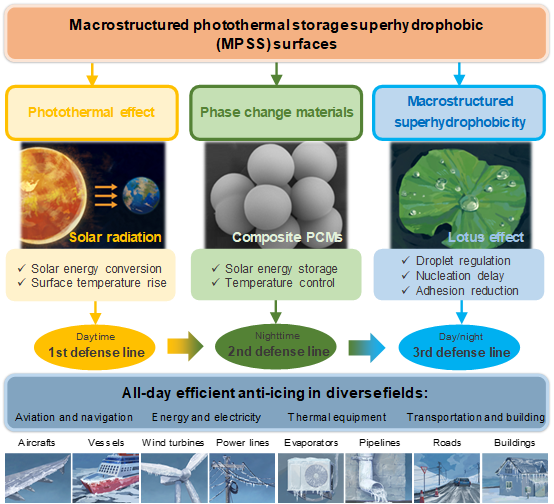
News

News
The innovation team ITEWA (Innovation Team for Energy, Water & Air) led by Prof. Ruzhu Wang from School of Mechanical Engineering at Shanghai Jiao Tong University, in collaboration with University of Science and Technology Beijing and Tsinghua University, published an article titled "Advanced Anti-Icing Strategies and Technologies by Macrostructured Photothermal Storage Superhydrophobic Surfaces" in Advanced Materials. Prof. Fuqiang Chu from University of Science and Technology Beijing and Dr. Zhifeng Hu from Shanghai Jiao Tong University are co-first authors of the paper. Prof. Yanhui Feng from University of Science and Technology Beijing, Prof. Xiaomin Wu from Tsinghua University, and Prof. Ruzhu Wang from Shanghai Jiao Tong University are corresponding authors.
This article reviews the latest progress on anti-icing technologies using superhydrophobic surfaces, analyzes current problems and remaining challenges, and proposes a strategy for all-day efficient anti-icing by constructing a multifunctional integrated macrostructured photothermal storage superhydrophobic surfaces, aiming to promote the development of advanced anti-icing technology.

Icing is a ubiquitous phase change phenomenon that widely exists in daily life and industrial processes. However, every year, icing causes huge economic losses and serious security threats to various fields such as energy and power, aviation and navigation, and infrastructure. For instance, in early 2024, the nationwide blizzards and freezing rain disasters resulted in large-scale power outages and traffic interruptions. The passive anti-icing technology that relies on surface properties has shown great potential due to the advantages of low energy consumption, high efficiency, and environmentally friendly. Among them, the anti-icing technology based on superhydrophobic surfaces has attracted widespread attention.
The paper introduces the anti-icing principle of superhydrophobic surfaces, and discusses the advantages and disadvantages of superhydrophobic surfaces in practical anti-icing scenarios. We reviewed the current development of macrostructured superhydrophobic surfaces (using macrostructures to regulate droplet motion) and photothermal superhydrophobic surfaces (using photothermal effect to enhance surface anti-icing ability at low temperatures), and discussed the limitations of the above two types of surfaces. A design strategy for macrostructured photothermal energy storage superhydrophobic (MPSS) surfaces was proposed by integrating superhydrophobic materials, photothermal materials, and phase change materials into one surface, which effectively enhances the all-day anti-icing ability.
MPSS surfaces construct multiple defense lines to achieve efficient all-day anti-icing in various applications: (1) Utilizing the inherent anti-icing properties of superhydrophobic surfaces to inhibit ice-nucleation and reduce ice adhesion; (2) Combining biomimetic structures to regulate droplet movement, weakening solid-liquid contact and strengthening droplet detachment; (3) By introducing the photothermal effect, the surface is heated up through photothermal conversion to avoid the failure of superhydrophobicity under low-temperature conditions; (4) Adding phase change materials for energy storage and stable temperature control, and thus solve the problem of energy imbalance in photothermal effects under different conditions.

This work establishes a design framework for advanced anti-icing superhydrophobic surfaces based on a multifunctional collaboration approach. It is recommended to introduce phase change materials to compensate for the limitations of photothermal superhydrophobic surfaces, and emphasize the importance of surface structure design for droplet manipulation. This framework is expected to inspire scientists and engineers to develop advanced anti-icing technologies based on superhydrophobic surfaces.
Prof. Ruzhu Wang's innovation team in the field of energy-water-air has long been committed to addressing fundamental scientific problems and key technologies at the forefront of the interdisciplinary intersection of energy, water, and air. Their aim is to achieve comprehensive solutions at the material-device-system level through interdisciplinary approaches, driving breakthroughs in related fields. In recent years, the team has published a series of interdisciplinary papers in high-level journals such as Science, Nature Review Materials, Nature Water, Joule, EES, Advanced Materials, and more.
Paper link: https://onlinelibrary.wiley.com/doi/10.1002/adma.202402897

Shanghai Jiao Tong University
Address: 800 Dongchuan Road, Shanghai
200240